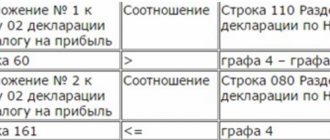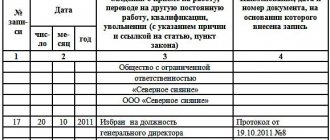This article provides short, universal instructions for an audit. So, if your company is suddenly faced with the need to conduct an audit, and you, as they say, “neither dream nor spirit” and have never seen an auditor before, then the main thing is not to panic, take this article and consider it every point honestly and impartially, compare what you have and what you lack, without giving yourself any concessions.
Accounting policy
One of the first documents that the auditor will ask you for is your organization's properly executed accounting policies . We remind you that the need to formulate an accounting policy and the basic requirements for its content and disclosure are enshrined in Article 8 of Federal Law 402-FZ “On Accounting”, as well as in PBU 1/2008 “Accounting Policy of the Organization”.
Key considerations regarding accounting policies generally include the following:
- The accounting policies are not properly drawn up or are out of date.
What does this mean? The accountant brings the accounting policy without a signature, just printed sheets with text, sometimes still warm from the printer. Or the other extreme: the accounting policy was properly approved, but it was so long ago that even the sheets have turned yellow, not to mention the fact that the content of such an accounting policy has long been outdated. - The accounting policies do not fully reflect the accounting methods used.
This means that you forgot to include in your accounting policies some of the actually used accounting methods. To avoid this, when preparing for the audit, check your accounting policies again for compliance with paragraph 4 of PBU 1/2008 “Accounting Policies of the Organization.” Your document must state: - working chart of accounts containing synthetic and analytical accounts necessary for maintaining accounting records in accordance with the requirements of timeliness and completeness of accounting and reporting
- procedure for conducting an inventory of the organization's assets and liabilities
- methods for assessing assets and liabilities
- document flow rules and accounting information processing technology
- procedure for monitoring business transactions
- other solutions necessary for organizing accounting
forms of primary accounting documents, accounting registers, as well as documents for internal accounting reporting
Financial statements
At this step, you need to check the completeness of your reporting, the consistency of accounting and reporting data, as well as the quality of completion. The fact is that some required fields or lines are not filled in automatically in 1C or in another accounting program, and we are all too accustomed to the fact that it is enough to click the “Fill” button. For example, in the balance sheet and income statement, the “Explanations” column must be filled out independently.
In addition, please note that if you are subject to a statutory audit, the reporting set must contain all forms, including attachments, and not be limited to a set of simplified financial statements. This norm is enshrined in paragraph 5 of Article 6 of Federal Law 402-FZ “On Accounting”. As a rule, a small business, encountering a mandatory audit for the first time, mistakenly provides an incomplete set, acting in accordance with paragraph 4 of Article 6 of the above-mentioned law, which allows small businesses to use simplified accounting methods, including simplified financial statements.
Reconciliation reports for counterparties
Paragraphs 73 and 74 of the Regulations on accounting and financial reporting in the Russian Federation state:
- settlements with debtors and creditors are reflected by each party in its financial statements in amounts arising from the accounting records and recognized by it as correct
- The amounts reflected in the financial statements for settlements with banks and the budget must be agreed upon with the relevant organizations and identical. Leaving unresolved amounts for these settlements on the balance sheet is not permitted.
Thus, the law does not establish mandatory reconciliations with counterparties when conducting an inventory of receivables and payables, with the exception of reconciliations with the bank and the budget.
In practice, the auditor, on a selective or continuous basis, will ask you for signed reconciliation reports with counterparties. The fact is that in his activities the auditor is obliged to be guided by auditing standards, which, in particular, indicate that audit evidence obtained from an independent source external to the audited entity (third-party confirmation) is more reliable. Therefore, when preparing for an audit, it is very important to check in advance, if not for all, then for the main counterparties, especially since accounting errors may be identified during the reconciliation process.
What you need to know about auditing
An external audit demonstrates the reliability of financial statements. No more, no less. Other checks may be initiated in parallel to the audit.
There are companies that are required to provide financial reports to interested parties: shareholders, insurance companies, etc. To verify the accuracy of the reporting, an audit is initiated.
How to pass an audit? First you need to figure out what it consists of.
What they look at:
financial and accounting statements of the company, the viability of internal control mechanisms for the preparation of financial statements.
Who is ordering:
government auditors, creditors, shareholders and investors.
What are you interested in:
already completed transactions and events that could have a significant impact on the financial and accounting statements of the organization. Typically, issues of economic validity of management decisions are not considered.
How often is it done:
once a year, sometimes less. It all depends on the financial calendar.
Audit result.
Conclusion on the reliability of the financial statements provided. They may vary, so let's talk about them in more detail.
Inventory
In accordance with paragraphs 26 and 27 of the Regulations on maintaining accounting and financial reporting in the Russian Federation, in order to ensure the reliability of accounting data and financial reporting, organizations are required to conduct an inventory of property and liabilities, during which their presence, condition and assessment are checked and documented, in In particular, it is mandatory to do this before drawing up annual financial statements. Therefore, when preparing for an audit, make sure that your organization has carried out an inventory and its results are documented, since such a procedure as an inventory, due to its mandatory nature, cannot be ignored by the auditor. In addition, the inventory carried out in terms of receivables and payables allows us to identify doubtful or bad debts for which it is necessary to create a reserve.
Classification
There are different types of audit of an organization. Classification is carried out according to various criteria. Depending on the category, there are independent, internal, and state financial audits of the organization.
In the first case, the inspection is carried out by a third-party company in accordance with an agreement concluded with the management of the enterprise. A special service operating within the company structure is responsible for organizing internal audit. State inspections are carried out by authorized government agencies.
Depending on the profile of the enterprise, the audit can be general, insurance, banking, etc.
Inspections can also be voluntary or mandatory. In the first case, the initiator is the head of the enterprise. He also determines the timing and scope of the inspection.
Organizations specified in the legislation are subject to mandatory audit.
Reserves
At this stage, it is necessary to check whether a reserve for doubtful debts has been formed in the accounting records and how well the formed reserve corresponds to the inventory results as of December 31. The most common mistake in this matter is completely ignoring the obligation to form a reserve for doubtful debts, despite the clear requirement of the law for its formation in accordance with paragraph 70 of the Regulations on Accounting and Financial Reporting in the Russian Federation.
Also make sure that your company has created a reserve to pay for vacations of the organization's employees, which is an estimated liability. In accordance with paragraph 3 of PBU 8/2010 “Estimated liabilities, contingent liabilities and contingent assets,” all organizations are required to reflect estimated liabilities, with the exception of those who have the right to use simplified accounting methods. I repeat once again that if your organization is a small business, but is subject to mandatory audit, then you cannot use simplified accounting methods.
Which companies must undergo mandatory audits?
Some can live without an audit. Others are required by law to go through it annually.
Globally, audits are divided into mandatory and voluntary.
Mandatory.
It is regulated by the law of the Russian Federation (more on it later) and is held once a year. Only audit companies are the performers, and the process itself is under the control of government authorities or is carried out on the basis of a decision of the judicial authorities.
Voluntary
(initiative).
Initiated by the company itself. Let's say the owner wants to find out the correctness of the current financial statements and avoid potential problems with the Tax Service.
Let's return to mandatory checks. The legislator has established a list of organizations required to undergo an audit. This:
- joint stock companies;
- companies whose revenue for the previous year exceeded 400 million rubles;
- companies whose securities are admitted to organized trading;
- credit and insurance companies;
- if the company discloses annual consolidated financial statements;
- companies in whose authorized capital the share of state ownership is at least 25%;
- if information on the results of a mandatory audit is subject to inclusion in the Unified Federal Register of Information on the Facts of the Activities of Legal Entities;
- companies whose balance sheet assets at the end of the previous year exceeded 60 million rubles.
Source documents
Of course, you won’t be able to eliminate the auditor’s possible comments regarding the primary documents in one day; this is exactly the case when it is better to do everything correctly right away, namely, keep under control not only the timeliness of receipt of original documents, but also the “quality” of your primary documentation. You will be surprised, but for the most part, auditors’ comments on primary documents refer to paragraph 2 of Article 9 of Federal Law 402-FZ “On Accounting,” which lists the mandatory details of the primary document, or to paragraph 1 of the same article, which states that Each fact of economic life is subject to registration with a primary accounting document. Thus, typical comments regarding primary documentation boil down to the following:
- the primary document was drawn up in violation of current legislation
- primary document missing
As a rule, based on the results of an audit, there are always comments on primary documents, so it would be useful to pay special attention to this issue when preparing, and it is better to start preparing a year before the audit J.
Objects
The list of enterprises that must conduct an annual audit is contained in the Federal Law “On Auditing Activities”. Such enterprises include:
- firms that are issuers of securities traded on the stock exchange, as well as companies operating professionally in the stock market;
- enterprises engaged in clearing or insurance activities;
- mutual funds, pension funds, as well as non-state extra-budgetary funds;
- financial institutions, namely banks, microfinance organizations and others;
- currency, commodity and stock exchanges;
- joint stock enterprises;
- firms publishing their reports in the public domain;
- other companies whose annual income exceeds 400 million rubles, as well as companies with assets worth more than 60 million rubles by the end of the reporting period.
Tip 1: How to audit an enterprise
The activities of any enterprise are subject to mandatory audit
, which is a verification of the reliability of the financial statements of the organization, its compliance with legislation in the field of accounting.
The audit also consists of monitoring the activities of the company, as a result of which clarifications and clarifications regarding the operation of the enterprise .
Instructions
- Audits can be mandatory or proactive. In the first case, they are held annually and are regulated by Russian legislation. Joint-stock companies, credit organizations, insurance companies, commodity and stock exchanges, and investment funds are subject to mandatory audit.
- An initiative audit is a check of the accounting and reporting of a company under an agreement with an audit company. At the same time, the scope of the audit may vary from the entire accounting and reporting system to its individual part. The most important goal of a proactive audit for a company is the ability to predict bankruptcy.
- The basic principle of conducting an audit is to determine the relationship between costs and results. It is necessary to agree in advance with the company on the scope of work, the timing of the inspection, as well as the method of providing information about the company’s activities. In some cases, auditors go directly to the enterprise, sometimes the company independently submits data.
- The audit begins with a review of the enterprise's and preparation for the audit. In this case, the cost of costs is calculated, as well as an assessment of the auditor’s risk during the audit.
- Next, audit procedures are carried out directly, with the help of which the compliance of the company’s internal control system with the required standards is determined. After which an audit report is drawn up, and then it is transferred to the head of the company. At the same time, violations identified during the inspection are indicated and the level of reliability of the submitted reports is calculated.
Requirements for audit organizations (auditors)
An audit organization (individual auditor) has the right to conduct audits and provide audit-related services if it is a member of a self-regulatory organization of auditors. These are the requirements of Part 1 of Article 3, Part 1 of Article 4, Part 2 of Article 23 of the Law of December 30, 2008 No. 307-FZ.
Auditors (auditing organizations, individual auditors) are not entitled to conduct an audit if:
- the auditor (his director or officials) is the founder (participants, shareholders) of the organization being audited;
- the auditor (his manager or officials) holds a position responsible for organizing and maintaining accounting and reporting in the audited organization (for example, manager, accountant);
- the auditor (his manager or officials) is closely related to the officials responsible for organizing and maintaining accounting and reporting in the audited organization (for example, a manager, an accountant);
- the organization being audited is the founder (participant, shareholder) of the auditor;
- the organization being audited is a subsidiary of the founder (participant, shareholder) of the auditor;
- the audited organization and the auditor have common founders (participants, shareholders);
- during the three years preceding the audit, the auditor maintained (restored) accounting in the audited organization or prepared its financial (accounting) statements;
- the audited organization is an insurance company with which the auditor has entered into a liability insurance agreement.
This is provided for in Article 8 of the Law of December 30, 2008 No. 307-FZ.
Tip 2: How to conduct an audit
The goal of any audit should be the extent to which the audit is needed. This may be the objective state of financial activity, economic strategy and internal verification of control of one or another structural form. Improving the company's performance should be a top priority in the audit.
Typically, a mandatory audit is carried out before the annual report is submitted. If an audit is carried out in several stages, the company can achieve a number of advantages, namely:
- Rates quoted at the end of the calendar year are usually higher because this is when most firms conduct audits.
- Your company will not need to change data in accounting and tax accounting just before submitting annual reports
- Limited time will definitely lead to errors in correction
It is advisable to conduct an audit distributed over several periods. For example, six months and the subsequent third quarter. In this situation, the accounting department will have enough time to correct various shortcomings. At the end of the year, all that remains is to check the corrections based on the comments made earlier. The last quarter will not be so busy. Thus, the burden on the finance department becomes minimal, and the cost of the audit is reduced through a phased audit.
The service, which is carried out when there is a change of owner, chief accountant, or during reorganization, is called a proactive audit. The main thing in such an audit is to assess the efficiency of the enterprise and the state of accounting. With this form of audit, the manager can check any departments where cost calculations were made and the correctness of taxation. As a result, your company will be able to pass all tax audits.
Express audit is carried out in cases of brief analysis. This may be a reporting period of a certain time associated with a change in the chief accountant or various personnel changes in departments.
The expert auditor's recommendation usually contains a number of explanations for the analysis of the client's financial activities. Based on any results of the audit, the auditor must issue documents to the customer-client with a detailed report on the work done and a conclusion that determines the correctness of the financial statements.
Recently, the services of audit firms have become widely used. Right now, many enterprises, even those for which annual inspections are not mandatory, are asking for inspections more and more often. Responsible selection of auditors and the goals set by the company are the key to a competent commercial strategy.
How is the internal audit service created and operated in an organization?
The internal audit service in an organization is created on the basis of an order from the head. The necessary methodological documents are being developed for it. Third-party specialists may be involved in the work (clause 18.2 of the information of the Ministry of Finance of Russia No. PZ-11/2013).
Methodological documents must contain a description of:
- goals, objectives and objects of control;
- functions assigned to the internal audit service;
- structure of the service and distribution of responsibilities in it;
- procedures applied;
- types of documents drawn up;
- criteria for assessing the performance of the service.
Each internal audit (regardless of whether it is planned or unscheduled) will necessarily consist of three stages:
- Preparatory, which determines the range of issues to be checked, the timing and methods of verification.
- The main thing is that control is carried out during it.
- Final, intended for data processing and reporting.
The questions to be checked are entered into a checklist reflecting:
- subject and method of verification;
- questions detailing the situation on the subject of inspection;
- the results of the answers to these questions;
- inspectors' comments.
The checklist allows you to logically correctly organize the control process, so it is the main working document when conducting an audit.
Tip 3: How to conduct an internal audit
Internal audit is carried out in order to obtain truthful information about the financial and material condition of the organization. It evaluates the methods and procedures of the business system for their productivity and effectiveness.
Instructions
- Before conducting an internal audit, you need to decide on the purpose and objectives that you would like to see as a result of the auditors’ work. The creation of your own audit may be negatively accepted by the employees of the enterprise, which may negatively affect the work of the organization. Therefore, it is necessary to convey to all services and departments of the enterprise that the audit is intended to control not employees, but the work process, identifying shortcomings and deviations in work, thereby helping to achieve better results.
- At the board of directors or at a meeting of founders, a decision is made to create an internal audit; such a decision is recorded in the relevant documents.
- The rules and powers of internal audit are formalized in a written document, which is signed by the board of directors or founders of the company.
- Before conducting an audit, auditors write a plan that specifies the method of carrying out procedures and the scope of work. The plan is signed by the head of the organization. If necessary, the manager gives written explanations about the work of the enterprise.
- If, when auditing a production process or similar operation, a specialist with specific knowledge is needed, then an outside professional is hired for such an audit and an appropriate agreement is signed with him.
- After conducting its own audit, the department issues a report in which the responsible auditor expresses an opinion on all material relationships and makes detailed recommendations. When expressing an opinion, the auditor is guided by the standards in accordance with the professional code of ethics for auditors.
- The audit department must conduct an internal audit on one assigned task until all errors and deviations are corrected.
- Remember that the auditor is independent of the company's management. This is the only way to ensure the reliability of the data provided in the auditor’s final report.
What is checked during the internal audit process
Conducting an internal audit requires an integrated approach. That is, all aspects of the enterprise’s activities are checked. In particular, these are:
- Maintaining records of fixed assets, intangible assets, cash transactions, financial results, capital and other things.
- Transactions on foreign currency, settlement and other accounts, settlements with counterparties, insurance companies.
- Condition of the operating system, documentation of funds, correctness of depreciation calculations, execution of the repair work plan.
The auditor must also ensure information security. The processing of information in the company, the current information system, and the presence of trade secrets are checked. A specialist conducts an audit of the information security system.







